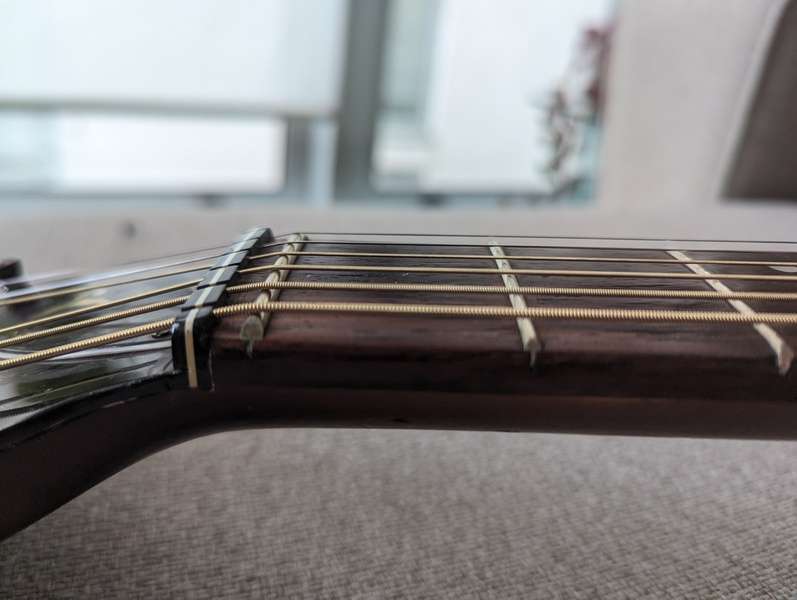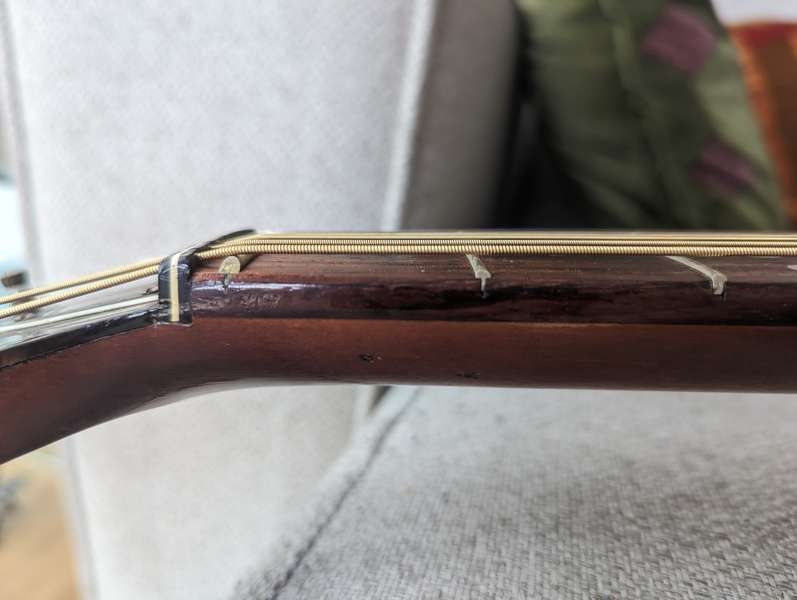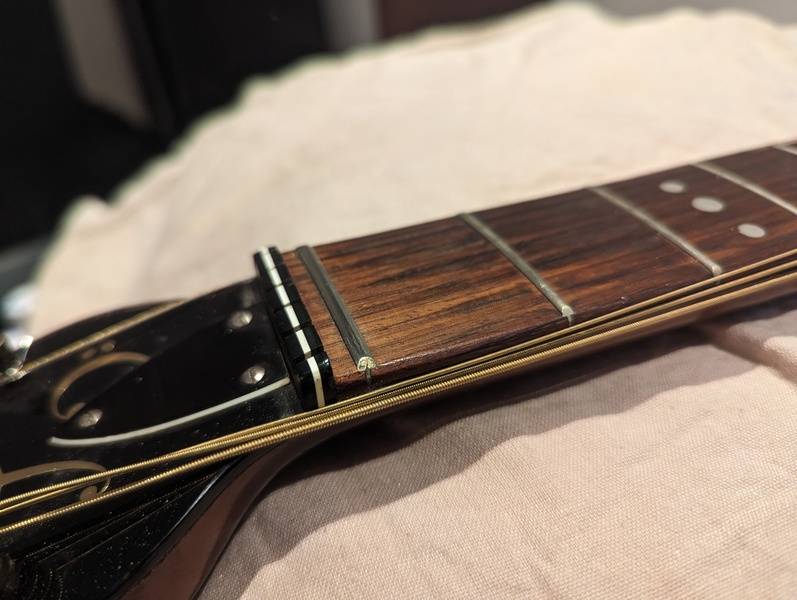
 |
|
#1
|
|||
|
|||
|
Hello everyone,
I'm excited to share that I've recently acquired my first acoustic archtop, a 1960 Hofner Senator, which also happens to be my first guitar with a zero fret. However, upon closer inspection, I've noticed that the zero fret on this guitar is noticeably thicker and taller than all the other frets. My understanding was that zero frets are typically uniform in size and height compared to the rest of the frets. Now, I'm wondering if there's something I'm overlooking here or if perhaps the frets on this guitar were modified incorrectly at some point in its history. Despite setting the action at the 12th fret correctly (around 2.5mm) and ensuring the neck is nearly straight, I'm unable to lower the action at the first fret beyond approximately 1mm (0.04"). Ideally, I'd like to achieve a lower action, around 0.5mm, but the oversized zero fret seems to be hindering this adjustment. Could someone clarify whether this discrepancy is standard, and if not, what would be the best course of action? Should I consider replacing the fret altogether, or would sanding it down suffice? Any insights or advice would be greatly appreciated. Thank you!   
Last edited by ChordophoneChr.; 01-27-2024 at 08:56 AM. Reason: Pictures did not seem to display correctly, now fixed hopefully. |
|
#2
|
|||
|
|||
|
If I use a zero fret I use the same fret wire but I don't dress it with all the other frets. I install it to it's full height. In 'theory' a nut slot is supposed to be the same height as the frets in front of it but in practice I find that the E and A string and even the D need a bit of extra height so that players can pound on open chords.
that fret does look rather tall. Any guitar tech should be able to adjust that for you. To check it fret a string at the 3rd fret and observe the string height over the top of the 1st fret. It should have a paper thin bit of airspace over the 1st. |
|
#3
|
|||
|
|||
|
Quote:
Thank you kindly for taking the time to respond. It's interesting to note that even with the third fret fretted, there's still quite a bit of space over the first fret, almost enough to fit a small novel (over 1mm). I'm quite enthusiastic about working on my guitar myself. I've dabbled in some repairs on flattops, and I'm eager to steadily enhance my skills to eventually construct a guitar from scratch. Would the guitar technician typically file down the zero fret to be slightly higher than the other frets in this situation? Your insights would be greatly appreciated! |
|
#4
|
|||
|
|||
|
A good rule of thumb is 0.002" clearance over the first fret when the string is fretted between the second and third frets. A strip of copy paper makes an acceptable feeler gauge.
|
|
#5
|
|||
|
|||
|
Yeah 1mm is WAY to much. How I would go about fixing that is to file the zero fret down in place using the depth gauge on my calipers to get it close to the fret in front of it. When it's close I would use a crowning file and carefully finish it off.
|
|
#6
|
|||
|
|||
|
The zero fret should be the same fret as all the other frets. When crowning, you can leave the zero fret untouched to leave it a little bit higher, especially if you like really low string height at the 12th fret and don't want back buzz behind the fretted strings.
|
|
#7
|
|||
|
|||
|
Thank you all for the pointers, really helpful.
Any tips on how to quickly/efficiently get this fret filed down? At my current rate using a grinding stone/sandpaper/fret files it is going to take me about 6 hours. |
|
#8
|
|||
|
|||
|
A diamond flat file, a crowning file, micromesh, wire wool and a Vernier calliper (use the bit that sticks out of the bottom so you can measure the fret height accurately).
Loosen strings and move them out of the way (the bridge will fall off, so mark where that goes with tape before you start). Measure the first fret height (and the second fret just to double check the first fret height). Measure the zero fret height. File down the zero fret (a flat diamond file will take off lots of nickel fast!!!) to just above the first fret height. Re-crown. Polish with micromesh and wire wool. Re-string. Time about 30-45 mins.
__________________
I'm learning to flatpick and fingerpick guitar to accompany songs. I've played and studied traditional noter/drone mountain dulcimer for many years. And I used to play dobro in a bluegrass band. Last edited by Robin, Wales; 01-28-2024 at 10:19 PM. |
|
#9
|
|||
|
|||
|
Rethinking this a bit what I owuld consider doing is 'slotting' the zero fret with my nut files and when it's right on all 6 strings use the crowning file to level off to the slot depths.
You can use hardware store needle files. No need to buy expensive nut files for this. |
|
#10
|
|||
|
|||
|
I think I would just install a new fret the same size if the action is not currently suitable.
|
|
#11
|
|||
|
|||
|
Thank you for all the pointers everyone, most helpful.
Got it down to a more acceptable height, but will probably lower it a bit more at the next string change - ran out of elbow grease for now and I just want to play the thing! Before:  After:  Before:  After: 
|
|
#12
|
|||
|
|||
|
It's hard to tell by pics but you as the player will certainly notice a difference. One of the things most people notice in a good setup is a well tuned nut, or in your case, a zero fret. It makes the F-Chord from 'impossible' to 'I got this...' At least for beginners who need it most.
|
|
#13
|
|||
|
|||
|
Looking at the picture, the neck may have a bend upwards from the second fret to the zero fret. The rotation force coming from the string angle over the nut will bend up this weak spot on any neck/fretboard, more or less. A fretboard sanded perfectly flat with strings at tension will have a visible back bend from the second fret to the nut without strings at tension.
|
|
#14
|
|||
|
|||
|
The neck and fretboard are pretty straight, I think it's just the wide-angle camera giving that impression!
I'll probably take a bit more off the zero fret at the next string change. Last edited by ChordophoneChr.; 02-24-2024 at 10:43 AM. |
 |
|
| Tags |
| action too high, archtop, hofner, set up, zero fret |
|
|